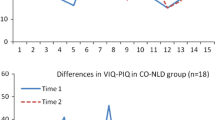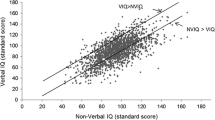Abstract
It has been suggested that children with nonverbal learning disabilities (NLD) or Asperger’s Syndrome (AS) may show difficulties with executive functioning. There were 3 groups in this study who completed a neuropsychological battery of visual-spatial, executive functioning, and reasoning tasks; AS (n = 37), NLD (n = 31), and controls (n = 40). Results indicated that children in both clinical groups scored within average limits on measures of spatial reasoning and verbal ability. Fluid reasoning was also found to be within average ranges for all groups. The AS group experienced significant problems with cognitive flexibility compared to the other two groups. In contrast the NLD group showed fewer difficulties with cognitive flexibility but more problems with visual sequencing. These findings suggest that performance on executive function measures for children with AS or NLD is remarkably similar with subtle differences present.



Similar content being viewed by others
References
American Psychiatric Association. (2000). Diagnostic and statistical manual of mental disorders (Fourth Text Revision ed.). Washington, D.C.: American Psychiatric Association.
Baron, I. S. (2004). Neuropsychological evaluation of the child. New York: Oxford University Press.
Corbett, B. A., & Constantine, L. J. (2006). Autism and attention deficit hyperactivity disorder: assessing attention and response control with the integrated visual and auditory continuous performance test. Child Neuropsychology, 12, 335–348.
Corporation, Psychological. (1999). Wechsler abbreviated scale of intelligence. San Antonio, TX: Harcourt Assessment, Inc.
Corwin, J., & Bylsma, F. W. (1993). Psychological examination of traumatic encephalopathy. The Clinical Neuropsychologist, 7, 3–21.
Davis, J., & Broitman, J. (2008). Nonverbal learning disabilities: Diagnosis and history. Paper presented at the International Neuropsychological Society, Waikoloa, Hawaii.
Delis, D.C., Kaplan, E., & Kramer, J. H. (2001). Delis-Kaplan executive functioning system: Examiner’s manual. San Antonio, TX: The Psychological Corporation.
Dennis, M., Francis, D. J., Cirino, P. T., Schachar, R., Barnes, M. A., & Fletcher, J. M. (2009). Why IQ is not a covariate in cognitive studies of neurodevelopmental disorders. Journal of the International Neuropsychological Society, 15, 331–343.
Fine, J. G., Semrud-Clikeman, M., Bledsoe, J., & Musielak, K. (2011). A critical review of the NLD literature as a developmental disorder. Child Neuropsychology, 17, 418–443.
Forrest, B. (2007). Diagnosing and treating right hemisphere disorders. In S. J. Hunter & J. Donders (Eds.), Pediatric neuropsychological intervention (pp. 175–192). Cambridge: Cambridge University Press.
Geurts, H., Verte, S., Oosterlaan, J., Roeyers, H., & Sergeant, J. A. (2004). How specific are executive functioning deficits in attention deficit hyperactivity disorder and autism? Journal of Child Psychology and Psychiatry, 45, 836–854.
Gillberg, C., & Billstedt, E. (2000). Autism and Asperger syndrome: Coexistence with other clinical disorders. Acta Psychiatrica Scandinavica, 102, 321–330.
Gresham, F. M., & Elliott, S. N. (1990). Social skills rating scale (SSRS). Circle Pines, MN: American Guidance Service.
Gunter, H. L., Ghaziuddin, M., & Ellis, H. (2002). Asperger syndrome: Tests of right hemisphere functioning and interhemispheric communication. Journal of Autism and Developmental Disorders, 32(4), 263–281.
Happe, F., Booth, R., Charlton, R., & Hughes, C. (2006). Executive function deficits in autism spectrum disorders and attention-deficit/hyperactivity disorder: Examining profiles across domains and ages. Brain and Cognition, 61, 25–39.
Hill, E. L. (2004a). Executive dysfunction in autism. Trends in Cognitive Science, 8, 26–31.
Hill, E. L. (2004b). Evaluating the theory of EF deficits in autism. Developmental Review, 24, 189–233.
Hill, E. L., & Bird, C. M. (2006). Executive processes in Asperger syndrome: Patterns of performance in multiple case series. Neuropsychologia, 44, 2822–2835.
Hughes, C. (1998). Executive function in preschoolers: Links with theory of mind and verbal ability. British Journal of Developmental Psychology, 16, 233–253.
Klin, A., Pauls, D. L., Schultz, R. T., & Volkmar, F. R. (2005). Three diagnostic approaches to asperger syndrome: Implications for research. Journal of Autism and Developmental Disorders, 35(2), 221–234.
Klin, A., Sparrow, S. S., Marans, W. D., Carter, A., & Volkmar, F. R. (2000). Assessment issues in children and adolescents with Asperger syndrome. In Ami Klin, Fred R Volkmar & Sara S Sparrow (Eds.), Asperger syndrome. New York: The Guildford Press.
Koning, C., & Magill-Evans, J. (2001). Validation of the childn and adolescent social perception measure. Occupational Therapy Journal of Research, 21, 49–67.
Le Couteur, A., Lord, C., & Rutter, M. (2003). Autism Diagnostic Interview-Revised. Los Angeles: Western Psychological Services.
Lezak, M. D., Howieson, D. B., & Loring, D. W. (2004). Neuropsychological assessment (4th ed.). New York: Oxford University Press.
Lord, C., Petkova, E., Hus, V., Gan, W., Lu, F., Martin, D. M., et al. (2012). A multisite study of the clinical diagnosis of different autism spectrum disorders. Archives of General Psychiatry, 69, 306–313.
Magill-Evans, J., Koning, C., Cameron-Sadava, A., & Manyk, K. (1995). The child and adolescent social perception measure. Journal of Nonverbal Behavior, 19, 151–169.
Magill-Evans, J., Koning, C., Cameron-Sadava, A., & Manyk, K. (1996). Manual for the child and adolescent social perception measure: Unpublished.
Minne, E., & Semrud-Clikeman, M. (2013). A social competence intervention for young children with high functioning autism and Asperger Syndrome: A pilot study. Autism, 16, 586–602.
Myklebust, H. R. (1975). Progress in Learning Disabilities (Vol. 3). New York: Grune & Stratton.
Nigg, J. T., Blaskey, L. G., Huang-Pollock, C. L., & Rappley, M. D. (2002). Neuropsychological executive functions and DSM-IV ADHD subtypes. Journal of the American Academy of Child and Adolescent Psychiatry, 41, 59–66.
Osterreith, P. A. (1944). Le test de copie d’une figure complexe. Archives de Psychologie, 30, 356.
Ozonoff, S., & Griffith, E. M. (2000). Neuropsychological function and the external validity of Asperger syndrome. In A. Klin, F. R. Volkmar, & S. S. Sparrow (Eds.), Asperger syndrome. New York: Guilford Press.
Perner, J. (1998). The meta-intentional nature of executive functions and theory of mind. In P. Carruthers & J. Boucher (Eds.), Language and thought: Interdisciplinary themes (pp. 270–316). Cambridge: Cambridge University Press.
Reddon, J. R., Gill, D. M., Gauk, S. E., & Maerz, M. D. (1988). Purdue pegboard: Test-retest estimates. Perceptual and Motor Skills, 66, 503–506.
Rourke, B. P. (1994). Neuropsychological assessment of children with learning disabilities: Measurement issues. In G. R. Lyon (Ed.), Frames of reference for the assessment of learning disabilities: New views on measurement issues (pp. 475–514). Baltimore, MD: Paul H. Brookes Publishing Co.
Rourke, B. P. (2000). Neuropsychological and psychosocial subtyping: A review of investigations within the University of Windsor laboratory. Canadian Psychology, 41, 34–51.
Rourke, B. P., & Tsatsanis, K. D. (2000). Nonverbal learning disabilities. In A. Klin, F. R. Volkmar, & S. S. Sparrow (Eds.), Asperger syndrome. New York: The Guilford Press.
Russell, J. (2002). Cognitive theories of autism. In J. E. Harrison & A. M. Owen (Eds.), Cognitive deficits in brain disorders (pp. 295–323). London: Martin Dunitz.
Saulnier, C., & Klin, A. (2007). Brief Report: Social and communication abilities and disabilities in higher functioning individuals with Autism and Asperger Syndrome. Journal of Autism and Developmental Disorders, 37, 788–793.
Schultz, R., Gauthier, I., Klin, A., Fulbright, R. K., Anderson, A., & Volkmar, F. R. (2000). Abnormal ventral temporal cortical activity among individuals with autism and asperger syndrome during face discrimination. Archives of General Psychiatry, 57, 331–340.
Semrud-Clikeman, M. (2003). Executive functions and social communication disorders. Perspectives, 29, 20–22.
Semrud-Clikeman, M. (2007). Social competence in children. New York: Springer.
Semrud-Clikeman, M., Fine, J. G., Bledsoe, J., & Zhu, D. (in press). Volumetric differences among children with Asperger Disorder, nonverbal learning disabilities, and controls on MRI. Journal of Clinical and Experimental Neuropsychology.
Semrud-Clikeman, M., Walkowiak, J., Wilkinson, A., & Butcher, B. (2010a). Differences on direct and indirect executive function measures among children with Asperger’s Syndrome, ADHD:combined type, ADHD:predominately inattentive type, and controls. Journal of Autism and Developmental Disorders, 40, 1017–1027.
Semrud-Clikeman, M., Walkowiak, J., Wilkinson, A., & Christopher, G. (2010b). Neuropsychological findings in nonverbal learning disabilities. Developmental Neuropsychology, 35, 582–600.
Stuss, D. T., Levine, B., ALexander, M. P., Hong, J., Palumbo, C., Hamer, L., et al. (2000). Wisconsin card sorting test performance in patients with focal frontal and posterior brain damage: Effects of lesion location and test structure on separable cognitive processes. Neuropsychologia, 38, 388–402.
Sylvester, C.-Y. C., Wager, T. D., Lacey, S. C., Hernandez, L., Nichols, T. E., Smith, E. E., et al. (2003). Switching attention and resolving interferences: fMRI measures of executive functions. Neuropsychologia, 41, 357–370.
Tiffin, J. (1968). Purdue pegboard: Examiner manual. Chicago: Science Research Associates.
Volkmar, F. R., Lord, C., Bailey, A., Schultz, R. T., & Klin, A. (2004). Autism and pervasive developmental disorders. Journal of Child Psychology and Psychiatry, 45, 135–170.
Volkmar, F. R., State, M., & Klin, A. (2009). Autism and autism spectrum disorders: Diagnostic issues for the coming decade. Child Psychology and Psychiatry, 50, 108–115.
White, S. J. (2013). The triple I hypothesis: Taking another’s perspective and executive dysfunction in autism. Journal of Autism and Developmental Disorders, 43, 114–121.
Woodcock, R. W., McGrew, K. S., & Mather, N. (2001a). Woodcock-Johnson III Test of cognitive abilities. Rolling Meadows, IL: Riverside Publishing.
Woodcock, R. W., McGrew, K. S., & Mather, N. (2001b). Woodcock-Johnson III tests of achievement. Itasca, IL: Riverside.
Wright, S. B., Matlen, B. J., Baym, C. L., Ferrer, E., & Bunge, S. A. (2008). Neural correlates of fluid reasoning in children and adults. Frontiers in Human Neuroscience, 1, 8–16.
Acknowledgments
We would like to acknowledge the support of the Department of Radiology at Michigan State University as well as the private foundation that chooses to remain anonymous that provided funding for this work.
Author information
Authors and Affiliations
Corresponding author
Rights and permissions
About this article
Cite this article
Semrud-Clikeman, M., Fine, J.G. & Bledsoe, J. Comparison Among Children with Children with Autism Spectrum Disorder, Nonverbal Learning Disorder and Typically Developing Children on Measures of Executive Functioning. J Autism Dev Disord 44, 331–342 (2014). https://doi.org/10.1007/s10803-013-1871-2
Published:
Issue Date:
DOI: https://doi.org/10.1007/s10803-013-1871-2




